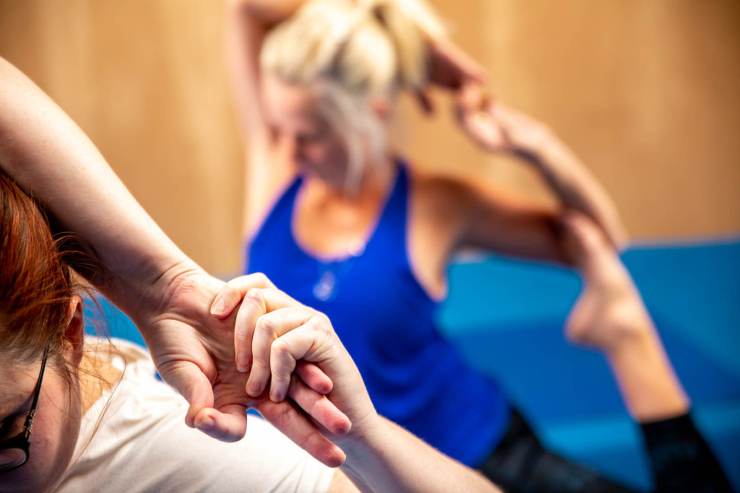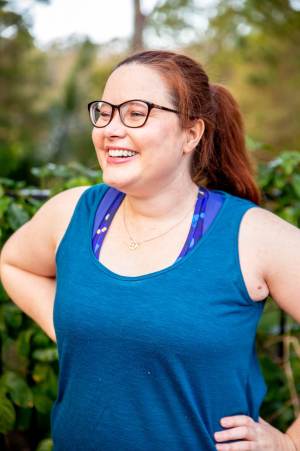Lifting lenses and lugging gear around for a full day shoot is no walk in the park. How do you avoid injuries as a photographer and keep your body safe when shooting?
Although mirrorless systems are making new kits lighter and easier to carry, photography can sometimes feel like a weight-training game! Wedding, event and sport photographers especially can generally be found lugging loads of heavy gear around, from telescopic lenses to tripods to multiple pro body cameras.
Add to that awkward angles, unbalanced gear and diving to the ground to get the perfect shot (or is that just me?), and photography is an injury waiting to happen.
I interviewed instructor Miranda Mitchell of Kickstart Martial Arts and Yoga to get her expert advice on the best way to protect yourself from injury when on a photoshoot. With over 25 years experience in martial arts and eight years of running her fitness business, Miranda’s practice is built around helping people feel comfortable in mind and body while moving in the ways you love.
What injuries or strains should photographers be aware of when working in the field lifting and carrying heavy gear?
It’s easy to become hunched over at the camera or slouched during editing. Around the lower back, the quadratus lumborum (QL), which is actually a deep abdominal muscle, can feel tight and strained. Lifting heavy loads can cause tension and pain in the upper back, too. Shoulders can also suffer a lot in photography.
Golfer’s elbow relates to pain around the forearms, and tennis elbow is not uncommon because of the repeated motions of photographers at the elbow. Carpal tunnel, with numbness in the hand, is another common complaint.

Can you give some tips on how to avoid injuries as a photographer when shooting in the field?
It is truly important to follow sensible workplace safety guidelines like bending at the knees, squatting, avoiding overload and mindfulness.
The chance of injury increases when we are distracted. It is easier said than done, but mindfulness of your body, not just the subject, is worth it to stick it out in the industry.
Try to be mindful by:
- Protecting your back by engaging your core before you reach for heavy gear.
- Bending from the knees, siting your weight into your heels, and lifting your chest. This will protect the back, and stops you hunching your shoulders.
- Without getting into the physics of pivots and levers, holding your camera close to your body will reduce strain. Anchor your elbow close to your body to support the camera’s weight and use the other hand to work the shutter.
- Move slowly between shooting positions to avoid getting a head spin or jarring anything!
Utilizing packs and harnesses can be great. Even some weightlifters use a waist support belt. Some people don’t like having straps around necks or tight belts, so use trial and error to find the kind of harness system that works for you.
The ideal harness distributes the weight evenly, supports the lower back and encourages your core to engage in a balanced way. You don’t want the harness to do all the work, because it’s important to let your core engage and gain strength. An ideal shoulder harness should draw your shoulders back and down, to open up the chest and expand the diaphragm.
What can photographers do before and after a shoot to protect from injury?
Incorporating a consistent routine to release tension and balance the body is ideal. Next time, we’ll go through some simple exercises that will really help avoid injuries as a photographer.

About Miranda
Miranda Mitchell is the owner of Kickstart Martial Art and Yoga and has been providing one-on-one and group training in yoga, martial arts and fitness for over eight years in Toowoomba and the Noosa hinterland on the Sunshine Coast in Queensland, Australia. She has been a martial arts practitioner across ITF Taekwon-Do, Anderson Bushi Kai and Muay Thai for over 25 years and developed the trademarked program Nimble Ninjas, which incorporates martial arts, yoga and mindfulness for 5-12 year olds.
She has a Certificate IV in Yoga Teaching, Diploma of Yoga Therapy, Certificate III in Fitness, Certificate IV in Personal Training, a Bachelor of Arts and a Bachelor of Education (Honours), and is a registered Teacher with Queensland College of Teachers, registered Yoga Therapist with Yoga Australia, registered Group Fitness Instructor, Personal Trainer and Sole Trader with Fitness Australia, and registered Martial Arts Instructor with Martial Arts Australia.
You can find Miranda online at Kickstart Martial Arts and Yoga and on Facebook. Get a free eBook on stretch and mobility by joining her mailing list here.
Look out for my next article in this series, where Miranda will take us through some simple sequences of exercises to protect your body when shooting.
Tell your story with the second annual Visual Storytelling Conference!
Experience four days of interactive, online training sessions featuring a range of educational content with experienced photographers and content creators. This free event kicks off with a series of technical boot camps to build essential skills, followed by live, online sessions on photography, video, business and social media. Join live from March 10-13, 2022!
